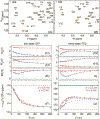Monitoring 15N Chemical Shifts During Protein Folding by Pressure-Jump NMR
- PMID: 29923716
- PMCID: PMC6119464
- DOI: 10.1021/jacs.8b04833
Monitoring 15N Chemical Shifts During Protein Folding by Pressure-Jump NMR
Abstract
Pressure-jump hardware permits direct observation of protein NMR spectra during a cyclically repeated protein folding process. For a two-state folding protein, the change in resonance frequency will occur nearly instantaneously when the protein clears the transition state barrier, resulting in a monoexponential change of the ensemble-averaged chemical shift. However, protein folding pathways can be more complex and contain metastable intermediates. With a pseudo-3D NMR experiment that utilizes stroboscopic observation, we measure the ensemble-averaged chemical shifts, including those of exchange-broadened intermediates, during the folding process. Such measurements for a pressure-sensitized mutant of ubiquitin show an on-pathway kinetic intermediate whose 15N chemical shifts differ most from the natively folded protein for strands β5, its preceding turn, and the two strands that pair with β5 in the native structure.
Figures



Similar articles
-
Interrupted Pressure-Jump NMR Experiments Reveal Resonances of On-Pathway Protein Folding Intermediate.J Phys Chem B. 2018 Dec 13;122(49):11792-11799. doi: 10.1021/acs.jpcb.8b08456. Epub 2018 Oct 10. J Phys Chem B. 2018. PMID: 30256104 Free PMC article.
-
Study of protein folding under native conditions by rapidly switching the hydrostatic pressure inside an NMR sample cell.Proc Natl Acad Sci U S A. 2018 May 1;115(18):E4169-E4178. doi: 10.1073/pnas.1803642115. Epub 2018 Apr 16. Proc Natl Acad Sci U S A. 2018. PMID: 29666248 Free PMC article.
-
Monitoring Hydrogen Exchange During Protein Folding by Fast Pressure Jump NMR Spectroscopy.J Am Chem Soc. 2017 Aug 16;139(32):11036-11039. doi: 10.1021/jacs.7b06676. Epub 2017 Aug 7. J Am Chem Soc. 2017. PMID: 28766333 Free PMC article.
-
High-pressure NMR spectroscopy for characterizing folding intermediates and denatured states of proteins.Methods. 2004 Sep;34(1):133-43. doi: 10.1016/j.ymeth.2004.03.010. Methods. 2004. PMID: 15283922 Review.
-
The use of high-pressure nuclear magnetic resonance to study protein folding.Methods Mol Biol. 2007;350:21-38. doi: 10.1385/1-59745-189-4:21. Methods Mol Biol. 2007. PMID: 16957315 Review.
Cited by
-
Real-time nuclear magnetic resonance spectroscopy in the study of biomolecular kinetics and dynamics.Magn Reson (Gott). 2021 May 11;2(1):291-320. doi: 10.5194/mr-2-291-2021. eCollection 2021. Magn Reson (Gott). 2021. PMID: 37904763 Free PMC article. Review.
-
Protein structural changes characterized by high-pressure, pulsed field gradient diffusion NMR spectroscopy.J Magn Reson. 2020 Mar;312:106701. doi: 10.1016/j.jmr.2020.106701. Epub 2020 Feb 19. J Magn Reson. 2020. PMID: 32113145 Free PMC article.
-
Chemical Exchange.Methods Enzymol. 2019;615:177-236. doi: 10.1016/bs.mie.2018.09.028. Epub 2018 Dec 4. Methods Enzymol. 2019. PMID: 30638530 Free PMC article.
-
Experimental NOE, Chemical Shift, and Proline Isomerization Data Provide Detailed Insights into Amelotin Oligomerization.J Am Chem Soc. 2023 Aug 16;145(32):18063-18074. doi: 10.1021/jacs.3c05710. Epub 2023 Aug 7. J Am Chem Soc. 2023. PMID: 37548612 Free PMC article.
-
Refolding of Cold-Denatured Barstar Induced by Radio-Frequency Heating: A New Method to Study Protein Folding by Real-Time NMR Spectroscopy.Angew Chem Int Ed Engl. 2020 Dec 1;59(49):22086-22091. doi: 10.1002/anie.202006945. Epub 2020 Sep 25. Angew Chem Int Ed Engl. 2020. PMID: 32744407 Free PMC article.
References
-
- Koide S; Dyson HJ; Wright PE, Characterization of a folding intermediate of apoplastocyanin trapped by proline isomerization. Biochemistry 1993, 32, 12299–12310. - PubMed
-
- Balbach J; Forge V; Vannuland NAJ; Winder SL; Hore PJ; Dobson CM, Following protein folding in real-time using NMR spectroscopy. Nat. Struct. Biol 1995, 2, 865–870. - PubMed
-
- Roche J; Dellarole M; Caro JA; Norberto DR; Garcia AE; Garcia-Moreno B; Roumestand C; Royer CA, Effect of Internal Cavities on Folding Rates and Routes Revealed by Real-Time Pressure-Jump NMR Spectroscopy. J. Am. Chem. Soc 2013, 135, 14610–14618. - PubMed
-
- Schlepckow K; Wirmer J; Bachmann A; Kiefhaber T; Schwalbe H, Conserved folding pathways of alpha-lactalbumin and lysozyme revealed by kinetic CD, fluorescence, NMR, and interrupted refolding experiments. J. Mol. Biol 2008, 378, 686–698. - PubMed
Publication types
MeSH terms
Substances
Grants and funding
LinkOut - more resources
Full Text Sources
Other Literature Sources

